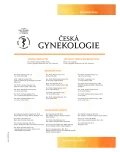Selective feticide in monochorionic twin pregnancies with discordant fetal anomalies: management and outcome
Authors:
J. Vojtěch; L. Hašlík; R. Pock; K. Běhávková; K. Macková; Petra Hanulíková; H. Heřman; L. Krofta
Authors‘ workplace:
Centrum fetální medicíny, Ústav pro péči o matku a dítě, Praha, ředitel doc. MUDr. J. Feyereisl, CSc.
Published in:
Ceska Gynekol 2017; 82(5): 345-350
Overview
Objective:
To analyze results and outcome after selective feticide for discordant anomalies in monochorionic twins.
Design:
Prospective cohort study.
Setting:
Fetal medicine center, Institute for the Care of Mother and Child, Praha.
Methods:
Analysis of outcome of monochorionic pregnancies after intrauterine surgery for structural abnormalities between January 2013 and June 2016.
Results:
We performed 13 intrauterine operations in monochorionic twins with structural anomalies during the period. There were 12 monochorionic diamniotic and one monochorionic monoamniotic twins. We encountered four cases of Twin Reversed Arterial Perfusion sequence (TRAP), six central nervous system lesions, two abdominal wall defects and one heterokaryotypic pregnancy with trisomy 13. In seven cases we performed bipolar cord occlusion, in four cases of TRAP sequence we performed radiofrequency ablation (RFA). We also performed laser photocoagulation of placental anastomoses in a case of gastroschisis complicated with twin-to-twin transfusion syndrome. One operation was unsuccessful for technical reasons – failing to perform amnioinfusion in a fetus with eventeration and anhydramnios. All procedures were performed in local anesthesia. Fetuses were born between 26 a 41 weeks of gestation (mean 35 weeks; 77% of fetuses were delivered after 32 weeks). Mean neonatal weight 2260 g. We encountered no intrauterine demise of a healthy fetus.
Conclusion:
Patients with discordant fetal anomalies in monochorionic twins can be offered a selective feticide via bipolar umbilical cord occlusion or radiofrequency ablation that are proven to be safe and effective.
Keywords:
monochorionic twins, discordant anomalies, radiofrequency ablation, RFA, bipolar occlusion, selective feticide, results, outcome, fetal medicine center
Sources
1. Campbell, D., van Teijlingen, ER.,Yip, L. Economic and social implications of multiple birth. Best Pract Res Clin Obstet Gynaecol, 2004, 18(4), p. 657–668.
2. Deprest, JA., Audibert, F., Van Schoubroeck, D., et al. Bipolar coagulation of the umbilical cord in complicated monochorionic twin pregnancy. Am J Obstet Gynecol, 2000. 182(2), p. 340–345.
3. Gaerty, K., Greer, RM., Kumar, S. Systematic review and metaanalysis of perinatal outcomes after radiofrequency ablation and bipolar cord occlusion in monochorionic pregnancies. Am J Obstet Gynecol, 2015, 213(5), p. 637–643.
4. Glinianaia, SV., Rankin, J., Wright, C. Congenital anomalies in twins: a register-based study. Hum Reprod, 2008, 23(6), p. 1306–1311.
5. Helmerhorst, FM., Perquin, DA., Donker, D., Keirse, MJ. Perinatal outcome of singletons and twins after assisted conception: a systematic review of controlled studies. BMJ, 2004, 328(7434), p. 261.
6. Hendrix, NW., Chauhan, SP. Sonographic examination of twins. From first trimester to delivery of second fetus. Obstet Gynecol Clin North Am, 1998, 25(3), p. 609–621.
7. Chen, CJ., Wang, CJ., Yu, MW., Lee, TK. Perinatal mortality and prevalence of major congenital malformations of twins in Taipei city. Acta Genet Med Gemellol (Roma), 1992, 41(2–3), p. 197–203.
8. Júnior, JE., Santana, EFM., Cecchino, GN. Monochorionic twin pregnancy – potential risks and perinatal outcomes, in contemporary gynecologic practice. Darwish, A. Ed. 2015, InTech. p. 221–222.
9. Lewi, L., Cannie, M., Blickstein, I., et al. Placental sharing, birthweight discordance, and vascular anastomoses in monochorionic diamniotic twin placentas. Am J Obstet Gynecol, 2007, 197(6), p. 587 e1–8.
10. Lewi, L., Gucciardo, L., Van Mieghem, T., et al. Monochorionic diamniotic twin pregnancies: natural history and risk stratification. Fetal Diagn Ther, 2010, 27(3), p. 121–133.
11. Lewi, L., Van Schoubroeck, D., Gratacos, E., et al. Monochorionic diamniotic twins: complications and management options. Curr Opin Obstet Gynecol, 2003, 15(2), p. 177–194.
12. Li, SJ., Ford, N., Meister, K., Bodurtha, J. Increased risk of birth defects among children from multiple births. Birth Defects Res A Clin Mol Teratol, 2003, 67(10), p. 879–885.
13. Napolitano, R., Thilaganathan, B. Late termination of pregnancy and foetal reduction for foetal anomaly. Best Pract Res Clin Obstet Gynaecol, 2010, 24(4), p. 529–537.
14. Rossi, AC., D‘Addario, V. Umbilical cord occlusion for selective feticide in complicated monochorionic twins: a systematic review of literature. Am J Obstet Gynecol, 2009, 200(2), p. 123–129.
15. Studnickova, M., Holuskova, I., Durdova, V., et al. Spontánní antepartální RhD aloimunizace [Spontaneous antepartal RhD alloimmunization]. Ces Gynek, 2015, 80(6), p. 401–404.
16. Van de Velde, M., De Buck, F. Fetal and maternal analgesia/anesthesia for fetal procedures. Fetal Diagn Ther, 2012, 31(4), p. 201–209.
17. Velebil, P. Vícečetné těhotenství, in Porodnictví, Hájek, Z., Čech, E., Maršál, K., Eds. Grada Publishing, 2014, p. 288–290.
18. Zahumensky, J., Gojis, O., Kiss, I., Kucera, E. Velamentous insertion of the umbilical cord of twin B as a cause of vasa previa in monochorionic diamniotic twins. Int J Gynaecol Obstet, 2013, 122(3), p. 261–262.
Labels
Paediatric gynaecology Gynaecology and obstetrics Reproduction medicineArticle was published in
Czech Gynaecology

2017 Issue 5
Most read in this issue
- What is the risk of pelvic organ prolapse recurrence after vaginal hysterectomy with colporrhaphy?
-
Screening of endometrial NK cells in selected infertile patients
First part – Methods and current results - Selective feticide in monochorionic twin pregnancies with discordant fetal anomalies: management and outcome
- Endometriosis and quality of life
